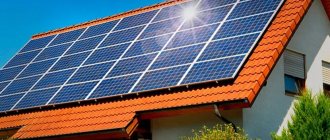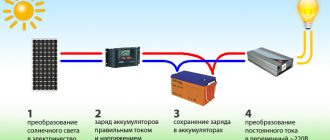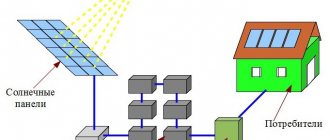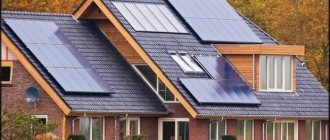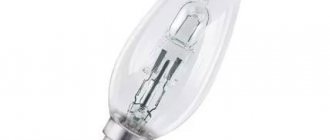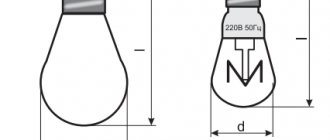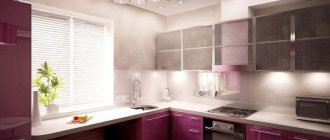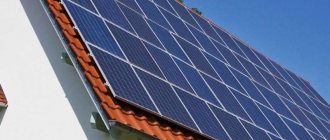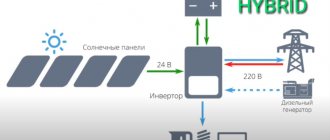Alternative energy is developing to its maximum in Europe, showing its promise with results. New types of solar panels are appearing and their efficiency is increasing.
If you want to ensure the operation of an industrial building or residential premises using solar energy, you must first learn about the differences between the equipment and understand which solar panels are suitable for the climatic conditions of a particular region.
We will help you sort out this issue. The article discusses the operating principle of photoelectric converters and provides an overview of different types of solar cells indicating their characteristics, advantages and disadvantages. After familiarizing yourself with the material, you will be able to make the right choice for arranging an effective solar system.
Installation of a solar power supply system and how much it costs
Converting the sun's energy into electricity - this idea kept scientists awake for a long time. With the discovery of the properties of semiconductors, this became possible. Solar cells use silicon crystals. When sunlight hits them, a directed movement of electrons is formed in them, which is called an electric current. When connecting a sufficient number of such crystals, we obtain quite decent currents: one panel with an area of just over a meter (1.3-1.4 m2) with a sufficient level of illumination can produce up to 270 W (voltage 24 V).
Electric solar panels for the home open up many possibilities
Since the illumination changes depending on the weather and time of day, it is not possible to directly connect devices to solar panels. We need a whole system. In addition to solar panels, you need:
- Battery. During daylight hours, under the influence of sunlight, solar panels generate electric current for the home or cottage. It is not always used in full; its excess accumulates in the battery. The accumulated energy is consumed in inclement weather.
- Controller. Not a mandatory part, but desirable (if you have enough funds). Monitors the battery's charge level to prevent it from over-discharging or exceeding its maximum charge level. Both of these conditions are detrimental to the battery, so having a controller extends the life of the battery. The controller also ensures optimal operation of solar panels.
- DC to AC converter (inverter). Not all devices are designed for direct current. Many operate on alternating voltage of 220 volts. The converter makes it possible to obtain a voltage of 220-230 V.
Solar panels for the home are only part of the system.
By installing solar panels for your home or cottage, you can become completely independent from the official supplier. But for this you need to spend a decent amount:
- A kit that produces 1.5 kW per day costs about $1000. This is enough to meet the needs of a summer house or part of the electrical equipment in the house.
- A set of solar panels to produce 4 kW per day costs about $2,200.
- For 9 kW per day - $6200.
Since solar panels for home are a modular system, you can buy an installation that will provide part of the needs, gradually increasing its productivity.
Which panel to choose?
For those who are deciding on the best solar installation for a country house with a latitude in the range of 45-60°, the choice is obvious. In this case, there are only two suitable options: mono- or polycrystalline silicon panels.
If there is not enough space to install the structure, you will have to use modern photovoltaic elements with one-sided arrangement of crystals. Otherwise, it is better to give preference to the polycrystalline battery option.
To determine the required power, the specific panel manufacturer and additional equipment necessary for installation, it is enough to use the services of consultants from enterprises involved in the production and sale of the relevant products. For reference, the price of solar panels from major global manufacturers does not differ significantly.
Those who want to take advantage of the “Turnkey installation of photovoltaic equipment” option should understand that the price of the panels themselves will be only 30% of the total cost of the entire work. For the project to pay off, you will have to wait at least 10 years, which is quite a long time. Everything will depend on the possibility of selling excess accumulated energy into the city grid and the level of consumption of the building itself.
Some customers prefer to assemble solar panels themselves. The procedure is not difficult to complete if you use the sequential operating instructions presented in text form on our website.
Types of solar panels
The solar battery itself is a number of photocells located in a common housing, protected by a transparent front panel. For household use, photovoltaic cells are produced on the basis of silicon, as it is relatively inexpensive. Elements based on it have a good efficiency (about 20-24%).
Monocrystalline, polycrystalline and thin-film (flexible) solar cells are made based on silicon crystals. A certain number of these photocells are electrically connected to each other (series and/or parallel) and connected to terminals located on the housing. This is called a solar battery or panel.
A solar panel for a home consists of a number of photocells
Photocells are installed in a closed housing. The solar battery housing is made of anodized aluminum. It is lightweight and non-corrosive. The front panel is made of durable glass, which must withstand snow and wind loads. In addition, it must have certain optical properties - have maximum transparency in order to transmit as many rays as possible. Due to reflection, a significant amount of energy is lost, so the requirements for the quality of the glass are high and it is also coated with an anti-reflective compound.
Types of photocells for solar panels
Solar panels for the home are made from three types of silicon cells;
- Monocrystalline. Each photocell is one silicon crystal. Monocrystalline solar cells have a good efficiency (about 24.7%), but their cost is somewhat higher. They can be distinguished, firstly, by their uniform, rich blue color, and secondly, by the rounded edges of the photocell.
Types of silicon photocells for solar cells - Polycrystalline. Several small silicon crystals are combined into one solar cell. They have a heterogeneous structure, which is why they absorb sunlight worse. This is reflected in the efficiency (20.3%). This effectively means that a solar panel of the same power will take up about 20% more space.
- Thin film. They are a semiconductor layer deposited on a flexible substrate. Due to their flexibility, they can be mounted on curved surfaces. They have low productivity (about 10.4%), so they occupy large areas (at least 2 times more than polycrystalline ones).
If you have a pitched roof and the facade faces south or east, there is no point in thinking too much about the space occupied. Polycrystalline modules may well suit this. For the same amount of energy produced, they cost slightly less.
How to choose the right solar panel system for your home
There are common misconceptions that make you spend extra money on overly expensive equipment. Below are recommendations on how to properly build a power supply system from solar panels and not spend extra money.
Solar power plants for the home may not be so expensive if you approach the issue carefully
What to buy
Not all components of a solar power plant are vital for operation. Some serve to increase reliability, but without them the system is functional. The first thing to remember is to purchase solar panels at the end of winter, beginning of spring. Firstly, the weather at this time is excellent, there are many sunny days, the snow reflects the sun, increasing the overall illumination. Secondly, discounts are traditionally announced at this time. The following are the tips:
- Buy solar panels for your home with an output voltage of 12 V. It is from this voltage that most household and construction equipment, LED lamps, etc. operate. There are much fewer equipment operating on 24 or 48 volts. You can look at passports or use the search.
- Do not use incandescent lamps for lighting. They consume too much electricity, and they operate on 220 V. Replace them with LED ones. For them, 12 V DC is what they need.
A “complete” solar power system looks like this - Do not try to immediately buy a high-power system to cover all possible needs. First, buy a couple of modules without a converter/inverter, connect to them the equipment that operates on constant voltage. If you are satisfied with the system, you can later increase the power, buy an additional inverter and connect equipment that operates on 220-230 V. And keep in mind that the inverter, even with the load off, consumes electricity (conversion losses are approximately 30%). That is, at night, when everything is turned off, it simply wastes battery power. Moreover, it produces a far from ideal sinusoid. In general, everything that can operate on constant voltage is powered directly from batteries.
If you use only these tips, and connect only equipment that runs on constant voltage, a solar panel system for your home will cost a much more modest amount than the cheapest kit. But that is not all. You can leave some of the equipment “for later” or do without it altogether.
What can you do without?
The cost of a set of solar panels for 1 kW per day is more than a thousand dollars. Considerable investment. You will inevitably wonder whether it is worth it and what the payback period will be. At current rates, you will have to wait for more than one year until you get your money back. But costs can be reduced. Not at the expense of quality, but due to a slight decrease in the operating comfort of the system and due to a reasonable approach to the selection of its components.
- Do not buy gel or deep cycle batteries. They are not worth the money. Even old car batteries work great with solar panels for the home. They work normally for at least another 5 years.
If the area is not limited, you can buy a solar battery based on polycrystalline photocells - In principle, you can get by with even less money. You don't have to install a controller. It costs at least $150 (and at high power $500), and its whole purpose is to monitor the state of charge of the batteries. If your budget is limited, buy a 12V car clock that also measures voltage and temperature. They cost $2-5 and practically perform the same function. And to avoid overcharging, buy an extra battery. Or two. The total power of the “extra” capacity should be at least 20%. This will avoid overcharging and increase the system capacity.
So, if the budget is limited, you can get by with several solar panels and batteries, the capacity of which is 20-25% higher than the maximum charge of solar panels. To monitor the condition, buy a car clock that also measures voltage. This will save you from having to measure the battery charge several times a day. Instead, you will need to look at your watch from time to time. That's all for the start. In the future, you can purchase additional solar panels for your home and increase the number of batteries. If desired, you can buy an inverter.
Converter types
Industrial versions of solar panels are divided according to the type of main layer and design features.
Depending on the type of device, they can be rigid or flexible. Due to their versatility in installation work, flexible panels are very popular among users. A significant plus is that they can be installed on any surface, not even a flat one.
Efficiency of solar cells
| Mono | 17-22% |
| Poly | 12-18% |
| Amorphous | 5-6% |
| Based on cadmium telluride | 10-12% |
| Based on copper-indium selenide | 15-20% |
| Polymer based | 5-6% |
Based on the type of main photovoltaic layer, alternative energy batteries are:
- indium-copper-gallium;
- polymer;
- tellurium-cadmium;
- silicon;
- gallium arsenide;
- organic;
- multilayer;
- combined.
Crystalline versions made of silicon and cadmium are popular among consumers, despite the fact that the efficiency of others is much greater. Everything is decided by the price of the structure itself and the cost of its installation.
Silicon panels heat up quickly: the start temperature of power generation is 25°C. However, increasing the parameter by 1°C reduces the efficiency of the installation by 0.5%.
Determining the size and number of photocells
Good 12-volt solar panels should have 36 cells, and 24-volt solar panels should have 72 solar cells. This amount is optimal. With fewer photocells you will never get the stated current. And this is the best option.
You should not buy dual solar panels - 72 and 144 elements, respectively. Firstly, they are very large, which is inconvenient for transportation. Secondly, at abnormally low temperatures, which we periodically experience, they are the first to fail. The fact is that the laminating film greatly decreases in size in cold weather. On large panels, due to high tension, it peels off or even breaks. Transparency is lost and productivity drops catastrophically. The panel is being repaired.
4V solar panel has 7 cells
Second factor. On larger panels the thickness of the body and glass should be greater. After all, windage and snow loads increase. But this is not always done, as the price increases significantly. If you see a double panel, and the price for it is lower than for two “regular” ones, it’s better to look for something else.
Once again, the best choice is a 12-volt home solar panel consisting of 36 solar cells. This is the best option, proven by practice.
Approximate prices
The price for different types of solar panels can vary from 30,000 to 2,000,000 rubles. It all depends on the number of modules, the quality of their execution, the manufacturer and the number of components. There are the most “budget” options that can cost from 10,500 rubles. The feasibility of their acquisition should be considered individually.
Solar panels are an alternative energy source that can be used as an efficient backup. The main thing is to take into account the climatic conditions of the region of residence. After all, the performance of such a system, for the most part, depends on the number of sunny days per year.
Technical specifications: what to look for
Certified solar panels always indicate operating current and voltage, as well as open-circuit voltage and short-circuit current. It is worth considering that all parameters are usually indicated for a temperature of +25°C. On a sunny day on the roof, the battery heats up to temperatures significantly higher than this figure. This explains the presence of higher operating voltage.
Example of technical characteristics of solar panels for a home
Also pay attention to the open circuit voltage. In normal batteries it is about 22 V. And everything would be fine, but if you carry out work on the equipment without disconnecting the solar panels, the open circuit voltage will damage the inverter or other connected equipment that is not designed for such a voltage. Therefore, during any work - switching wires, connecting/disconnecting batteries, etc. etc. - the first thing you should do is disconnect the solar panels (remove the terminals) . Having gone through the circuit, you connect them last. This procedure will save you a lot of nerves (and money).
A little about the scope
Solar batteries have been widely used for a long time in various spheres of human activity, from their installation at large industrial facilities to domestic use on the roofs of residential buildings and cars. Read more about industrial solar panels →
They are actively used:
- in villages and villages where electricity is often cut off;
- in conditions of weak electrification of the area;
- as backup energy sources;
- when implementing experimental projects (for example, using solar energy to produce hot water).
Case and glass
Solar panels for home have an aluminum body. This metal does not corrode and has sufficient strength and is light in weight. A normal body must be assembled from a profile containing at least two stiffeners. In addition, the glass must be inserted into a special groove, and not fixed on top. All these are signs of normal quality.
There should be no glare on the body
When choosing a solar battery, pay attention to glass. In normal batteries it is not smooth, but textured. It is rough to the touch; if you rub it with your nails, you can hear a rustling sound. In addition, it must have a high-quality coating that minimizes glare. This means that nothing should be reflected in it. If reflections of surrounding objects are visible at any angle, it is better to find another panel.
Where can I buy
A solar battery (panel) is a rather expensive device; moreover, as a rule, it is necessary to purchase several panels, so the best place to purchase is specialized organizations that sell solar power plants and their components.
Due to the fact that, as already written above, there are a large number of Chinese products on the market for such devices, you can use the purchase via the Internet. In this case, you need to use the same Internet to study reviews about the device you are purchasing, as well as reviews about the company that supplies it.
Russian and European companies have representative offices in different cities of our country; you can use their services, first, in the same way as when purchasing via the Internet, by reading reviews about the selected device.
Selecting the cable cross-section and the fineness of the electrical connection
Solar panels for your home must be connected using a single-core copper cable. The cable cross-section depends on the distance between the module and the battery:
- distance less than 10 meters: 1.5 mm2 per 100 W solar panel;
- for two batteries - 2.5 mm2;
- three batteries - 4.0 mm2;
- to connect one panel we take 2.5 mm2;
You can take a larger cross section, but not smaller (there will be large losses, but we don’t need it). When purchasing wires, pay attention to the actual cross-section, since today the declared dimensions very often do not correspond to the actual ones. To check, you will have to measure the diameter and calculate the cross-section (you can read how to do this here).
Solar panels for home: electrical connection
When assembling the system, you can draw the positives of solar panels using a multi-core cable of a suitable cross-section, and use one thick cable for the negative. Before connecting to the batteries, we pass all the “pluses” through diodes or diode assemblies with a common cathode. This prevents the battery from shorting out (which could cause a fire) if the wires between the batteries and the battery are shorted or broken.
Diodes use types SBL2040CT, PBYR040CT. If these are not found, you can remove them from old power supplies of personal computers. There are usually SBL3040 or similar ones. It is advisable to pass through diodes. Don’t forget that they get very hot, so you need to mount them on a radiator (you can use just one).
The system also requires a fuse box. One for each consumer. We connect the entire load through this block. Firstly, the system is safer. Secondly, if problems arise, it is easier to determine its source (by a blown fuse).
History of development
Solar batteries began their development back in the 19th century. The prerequisite for this was revolutionary research on the transformation of solar energy into a more material component.
The first solar panels had an efficiency of only 1%, and their chemical basis was selenium. The first contributions to the development of such batteries were made by A. Becquerel, W. Smith, and C. Fritts.
But using only 1% of the total energy supplied to the solar panel is very little. These elements could not provide uninterrupted power supply to the equipment, so research continued.
In 1954, three scientists - Gordon Pearson, Darryl Chapin and Cal Fuller - invented a battery with an efficiency of 4%. It worked on silicon, and subsequently its efficiency was increased to 20%.
Currently, solar panels produce only 1% of the world's energy. They are mainly carried out to places that are difficult to reach for electrification. This power source is widely used in the space industry. Experts believe that all paths are open to such a battery, since solar activity is increasing every year.
In our latitudes, these batteries are installed in private homes to save energy consumption and care for the environment.
Difficulties
The main problem is cleaning the silicon, or rather the cost of this process, as well as the orientation of the crystals within the panel in one direction.
In addition to silicon, other elements can be used for the manufacture of semiconductor converters - indium, for example. Their use does not affect the principle of operation - it does not change.
How to make it yourself using improvised materials
If you wish, have free time and minimal knowledge of electrical engineering, you can make a solar battery from improvised materials. There can be many options, it all depends on the available materials, “baggage” of knowledge and skills.
Similar devices can be made:
- From previously used transistors (electronic devices). In this case, the covers of the transistors are cut off and the transistors themselves are connected in series. When sunlight hits internal planes that have a “pn” junction, an electric current is generated inside them. The transistors are placed in a separate housing, the leads are soldered to the ends - the solar battery is ready.
- From diodes. To manufacture these electronic devices, you will need a large number of them, as well as an electronic board used as a substrate. The upper part of the diodes is cut off, the crystal is removed from the device body (heating is carried out and removal from the case). The extracted crystals are attached to the board by soldering into separate blocks. The connection is made in series to achieve the required voltage values. The assembled blocks are connected to each other in parallel.
- Made from copper sheet. The copper sheet is cleaned and then heated, using an open fire, an electric heating element or another heat source. During the heating process, the copper turns black, heating continues for some time, after which the sheet slowly cools. An electrode is cut from this sheet of such a size that it fits into a container prepared in advance, it can be a plastic bottle, a canister with a cut off top or another container, but the main condition is that it is made of a material that does not conduct electric current. From another sheet of copper that has not been heated, a second electrode is cut out, similar in size to the first. The electrodes are placed in a prepared container and attached to its walls, conductors are connected to them. The plates must not touch each other. The pure copper sheet is the positive pole, the heated sheet is the negative pole. Water in which rock salt is dissolved is poured into the container, the device is placed in sunlight - the battery is ready.
- From factory-produced photocells. In this case, first the photocells are assembled in a certain sequence on the substrate. A housing is made into which the assembled photocells are placed, and the housing is sealed. The battery is ready.
